I am growing a number of pelargoniums in pots. They add interest to the bright porch area of my greenhouse , gathered in a little huddle. I will also dot them around the garden during the summer and use them as outside table decorations. Here I share six of my favourite pelargoniums in pots from my slowly growing collection.
Pelargoniums grow well in pots because they are fine with a fairly dry compost. In fact they don’t like soggy roots, so allowing the compost to dry out in between waterings is a good idea. Mine are mostly planted in small terracotta pots filled with multipurpose compost mixed with sand and grit. As they grow I’ll pot them on into larger pots, either when they finish flowering, or next spring. My new collection of pelargoniums in pots will be overwintered in my greenhouse but a frost free porch or cool windowsill indoor would work too.
My go-to person for greenhouse growing is Anne Swinthinbank. She writes in her book ‘The Greenhouse Gardener’ how she finds it “hard to leaf through a pelargonium catalogue and behave decently”. So this section comes with a health warning for plantaholics out there…
Pelargonium ‘Lord Bute’
Lord Bute really is a beaut. I’ve noticed that pelargoniums with a different coloured edging really do glow (see also ‘Ardens’ below). Here the large burgundy petals are slightly ruffled and edged in almost luminous shocking pink. It wasn’t possible to capture the effect well on camera, but the leaves of this plant are covered in tiny hairs which glint silver in certain lights.
Lord Bute is from a category of Pelargoniums called ‘Regals’ which have showy petals. Ann Swithinbank advises that these should be cut back only after flowering ends and not pre-season in late winter. She also says that the ‘Regals’ generally don’t have a long flowering season although Lord Bute is an exception. This is a relief and I look forward to enjoying his company all summer long.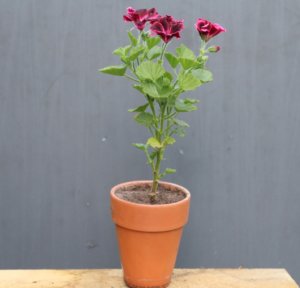
Pelargonium ‘Ardens’
This plant is a bobby dazzler. It is hard to convey just how pretty it is. On a dull day it glows in the greenhouse like a tiny port beacon. It is mesmerising. I think the reason for this is the bright edging surrounding the darker centre, which somehow plays tricks on your eyes.
This plant is one of the species/species-hybrid Pelargoniums, a group which Ann Swithinbank describes as “wild, wilful and a law unto themselves.” because they “sometimes die back at the slightest provocation”. When I’ve shared pictures of this plant before some fellow gardeners reported trouble getting it to flower. Also, the upright single stem makes it difficult to propagate but I have been given stubby root cuttings as well as this whole plant and I’m happy to report that these roots are starting to put out leaf. I will soon have two in my collection.
My friend reports no major tricks to keeping it happy, although she does keep it in a heated section of the greenhouse over winter. I’m not sure this is strictly necessary as long as it’s stored frost free. She repots each spring.
Pelargonium ‘Madame Nonin’
This pelargonium fills its pot well and looks well balanced. This is a type of pelargonium called ‘Unique’ which are similar to Regal types but are less blowsy, with daintier flowers and leaves. If you like baby pink, this is a good variety to go for and it has lovely deeper pink veined patterns on the petals and pretty whirligig purple anthers. The leaves have a pleasant lemony scent.
Pelargonium ‘Mystery’
Pelargonium ‘Mystery’ is a described by Sarah Raven as being part of the ‘Decorative’ group of pelargoniums, although this is not a group talked about in my book by Anne Swithinbank. Decoratives describe a wide range of pellies, mainly dating back to Victorian breeding.
‘Mystery’ is a lovely wine red colour, edged in claret with a central claret stripe. It’s got a good upright nature and should fill out into a good bushy specimen over the next few years. Rubbing a leaf to release the oils adds an extra dimension to this plant’s charm. Have you ever been to a posh spa? They’re not my natural habitat but when I have been to one I’m always struck by the scent they pump in – a combination of sandalwood, lavender and lemon. ‘Mystery’ has his sort of scent.
Pelargonium ‘pelgardini chocolate bush’
I would put this plant into the marmite category. It’s not as conventionally tasteful as some of the other flowers featured here but if you like interesting leaf shapes and colour as well as a bright intriguing flower – this is one for you.
Pelgardini pelargoniums are part of the zonal group, familiar to many as bedding and container pelargoniums sold by the millions each year for British gardeners. The pelgardinis are more unusual than the more common zonals on sale and tend to have interesting leaf forms and markings.
The leaves on this chocolate bush variety start out fresh green with browny centres before expanding into a seven-pointed fan shape of burgundy-brown. Standing proud above the mass of striking leaves is a strong stem carrying coral orange flowers. These are an interesting shape, with the upper petals resembling a cockerel’s comb. I’m really keen to see how this one bushes out over the summer and it certainly stands out in a group display.
Pelargonium ‘Sweet Mimosa’
This is one of the scented leaf group and if the flowers aren’t attractive enough, the leaf scent should attract you . When rubbed the leaves if this plant smell strongly of sandalwood mixed with lemon. Meanwhile the flowers are the colour of raspberry yoghurt. All round this is a good pelargonium for pots.
Some of these plants were bought as small mail-order plugs from Sarah Raven and others from my local garden centre in the early season summer bedding plug plant area. Fibrex nurseries have a large range and Hayloft Plants also sells some scented varieties. My ‘Ardens’ was a gift from a friend at the Chiltern Alpine Garden Society.
If you want to read other contributions to the Six on Saturday link up of gardeners click here to go to the page of host The Propagator If you’ve grown pelargoniums in pots do let me know which your favourites are – I’m on the look-out for more varieties to try.

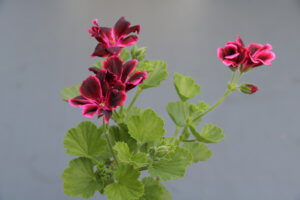
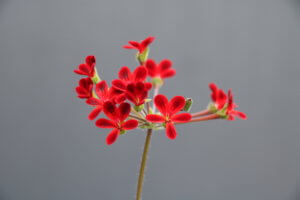

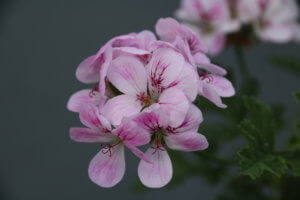
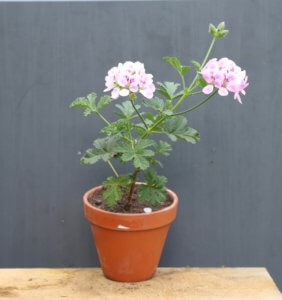
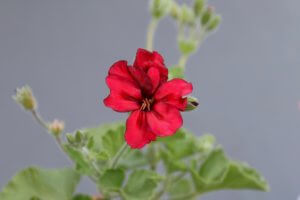
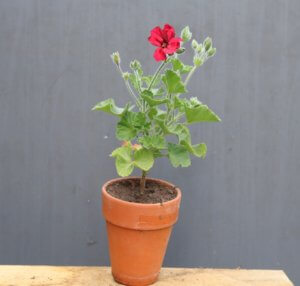
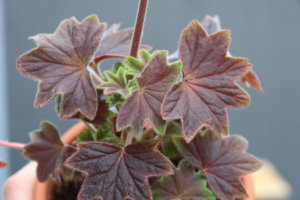
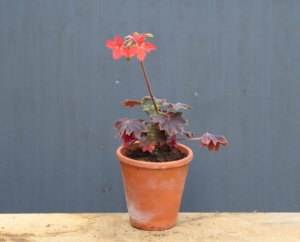
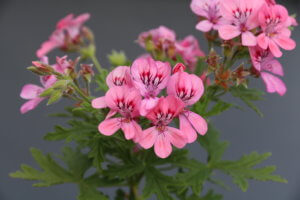
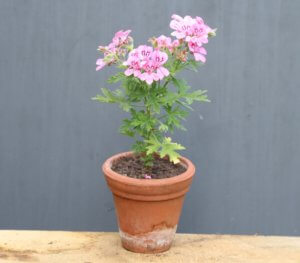

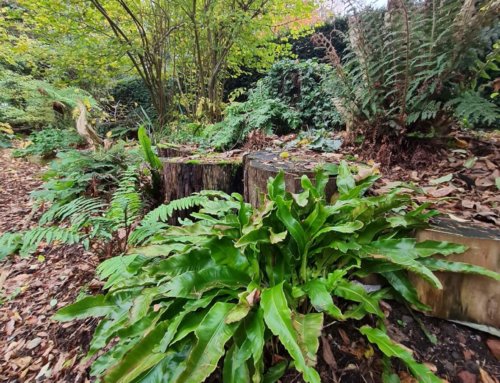
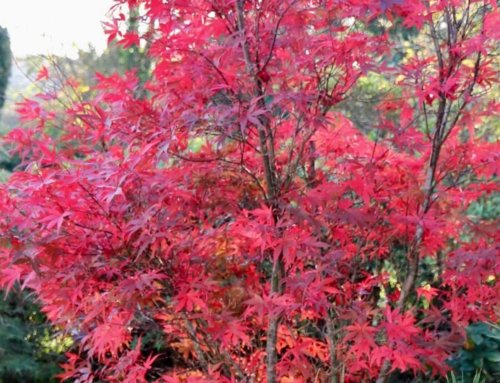
Lovely to see all these pelargoniums together. I always thought that Mystery was one of those labels put in when you aren’t sure what it is, now I know better! Arden is a stunner, just beautiful. 🙂
I know, I had to look twice at the label to see if that really was its name!
Lord Bute is simple, elegant. I love it !
Me too Fred. We ate lunch outside today and I put a few pellies in the centre of the table. Lord Bute was voted to family favourite.
Between you & Gill, I’m being pushed into the pellie direction. The fact that I bought some pots earlier this year that suck all the moisture out of the soil is yet another reason to succumb to temptation. I do like the chocolate bush – a bit of unusual foliage always makes a big impact w/me. Lord Butte is making me a bit weak in the knees as well. No wonder you’re hook on these lovelies.
I daren’t look at the catalogues as I know I’ll want to buy more. It sounds like those pots would be perfect for them. Maybe next year I’ll have some cuttings to share…
I didn’t realise there was such a variety to choose from. We have a lemon sherbet scented one. One of the few plants I can easily take cuttings of!
Fill the world with lemon sherbert cuttings, I say!
….’and behave decently!’ Perish the thought. They are all lovely but I think arden is my fave. I’ve only grown the bog standard pelly.
I was the same until this year. I need to perfect propagation as I think I’d like many more of these,,,
I saw on twitter you bought a barrowful this weekend! Yes, Ardens is special. I feel very grateful to my friend for her generous gift.
Lord Bute is a beaut. I had it last year but lost them over winter. Might try growing them again next year.
Oh no Paul, sorry to hear your Lord Bute is deceased. It’s sad to lose a precious plant. I’ll have to see how my overwintering goes…
I also like the phrase Zonal Group as the company I work for is called Zonal.
Hi Paul, you’re not the only one to have lost Lord Bute. He seems a but tricksy. Let’s see if he manages to survive next winter…
I love pellies and have quite a few. Sadly Lodr Bute died this winter, no idea why as he was bought a long with several other pellies and kept in the same location (a frost free conservatory). I may have to buy another one!
I have a few Pelargoniums that I grow in the conservatory, mostly scented leaf varieties. I’ve been trying not to add to them but you’ve featured some lovely ones!
Re Ardens: absolutely infuriating! No sign of a flower after three years.
[…] Katharine loves the electric colour of Pelargonium ardens, a species PelargoniumImage: The Tea Break Gardener […]
[…] Katharine loves the electric colour of Pelargonium ardens, a species PelargoniumImage: The Tea Break Gardener […]